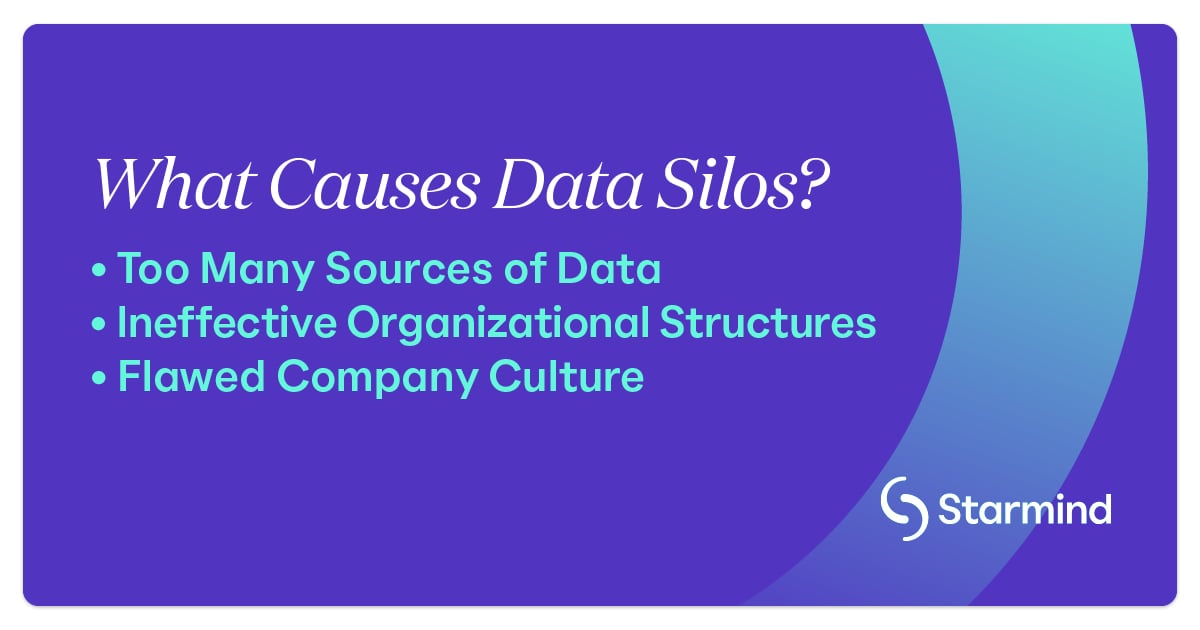Contents
The first image that comes to mind when picturing silos is a tall physical structure for storing bulk materials like grain. Unfortunately, silos in businesses can be harmful. Enterprises need to be breaking down data silos so that every employee has the key information and resources they need.
Physical silos store and protect grain, but data silos create barriers to employee alignment, transparency and business success. Removing these silos is imperative to improve your enterprise’s communication, efficiency and effectiveness.
How do data silos occur? They’re the unintended result of cultural habits and organizational structures. The best way to solve your data silos problem is by identifying and addressing their root causes.
Get started by learning more about the causes and disadvantages of data silos. Then, find out how to identify and eliminate these silos while making knowledge accessible to everyone who needs it.
What are data silos?
Data silos, also called information silos, can be created any time an employee hoards data or knowledge, whether it’s intentional or not. Perhaps you have a small team that focuses on a single project. Because those employees are close-knit, they share progress and results with their immediate teammates. But because these employees don’t interact much with other departments, their knowledge, results and processes aren’t shared or documented across the employee population.
This likely won’t cause immediate issues, but such teams can become more isolated over time. For example, imagine a sales team that isn’t aware of a new product launch because of data silos in an R&D department and a poor communication structure. Alternately, a new product design might lack a key feature or not address a common customer need because the sales and product teams suffer from ineffective communication and can’t easily view critical information.
Ultimately, employees need easy access to information to do their jobs. By breaking down data silos, you can make it easier for teams to find answers or get help fast, which helps them make more informed decisions and deliver better results.
What causes data silos?
Missing or inaccessible knowledge
There is a massive amount of data within your organization, but it’s important to make it accessible for everyone that needs it. Research suggests that up to 80% of the knowledge within organizations is undocumented. While common information such as company or product information and best practices are frequently documented, a significant amount of important job-related knowledge is gained through experience. As employees become more knowledgeable and experienced, they’re more likely to share their findings with those most closely involved with their work. While this can help their immediate teams and projects, it limits broader knowledge sharing and makes it difficult to determine where knowledge can be found and who has access to it.
Too many sources of data
Enterprises benefit from a centralized location where anyone on your team can access critical data. Such platforms unify information from across the enterprise. By contrast, employees needing to navigate multiple knowledge systems might not have the correct logins or understand how each system operates. In short, they spend too much time hunting for data, guessing at answers and duplicating work — even if they find the information they need.
Rapid business growth or acquisitions can also create organizations where data sources are scattered across departments, platforms and physical locations. These silos are easier to identify, but dismantling them requires substantial work and attention. Technological issues such as outdated or incompatible systems can be especially problematic as they can make it difficult to access, update, preserve and share information. For example, some companies and industries generate enormous amounts of big data and require extensive support to interpret what’s available. All of these factors add further complexity to communication and knowledge sharing.
Ineffective organizational structures
Many organizations attempt to simplify each team’s work so employees can focus on their part of the work with clearly defined resources and people, but this often leads to teams prioritizing their respective objectives over broader goals. Inevitably, these organizations become unwieldy and fragmented, with little data sharing across subsidiaries, business units and geographies.
For example, consider a large sales organization that separates its team into East Coast and West Coast divisions to manage smaller territories with greater attention. This can help analyze performance and respond to needs on a local level, but it can also lead to sales cannibalization, confusion or internal turf wars. When sales representatives across units can’t access or share appropriate knowledge, they might make conflicting proposals to a customer with a presence in both territories. This introduces confusion at best and lost revenue at worst.
Flawed company culture
Company culture also plays a big part in creating or breaking down data silos. Departments or business units might safeguard data for security reasons, but they might also do so because of fear or self-interest. Your company’s cultural or sales Incentives can also unintentionally create silos, as employees may view their knowledge and experience as a competitive advantage. Poorly designed employee contests, sales quotas or commissions can lead to employees refusing to share key information, for instance.
Data silo disadvantages and potential to damage your organization
Data silos aren’t just a problem of logistics or structure; their presence can harm your company’s operations, revenue and profit. Here are common issues associated with silos.
Bottom line impact
Data silos can impact your bottom line by more than just stifling progress. They can slow your entire business and drive unnecessary expenses. Teams can waste hours every week searching for information that may not be available or correct. Not only does this create extra work, but it can lead to a negative employee or customer experience. Breaking down these silos creates cost-saving opportunities, and it can help drive more revenue. Sales and customer service teams can answer questions faster, and with greater detail. Turnaround time on proposals submissions can be improved. R&D teams can create innovative solutions faster and improve your time to market.
Harms productivity
Gaps in knowledge make your business less efficient and can contribute to a loss in productivity. About 50% of workers say they spend too much time searching through documents, affecting their capacity for deep work. When employees search for information rather than focusing on core tasks, they get less done, become frustrated and potentially duplicate work already performed elsewhere in the enterprise.
Discourages collaborative work
Collaboration leads to faster, better results with less time and overall effort, but silos limit the opportunities for collaborative efforts. Software platforms that naturally encourage collaboration, such as knowledge management systems, give employees an easy way to find information and consult expert colleagues for additional insight. That collaboration feeds on itself, but with silos, your employees miss out on being productive teammates.
Affects business management
To manage your business effectively, you need visibility into the performance of every team and process. This knowledge and insight are essential to aligning teams, strategies and data. When business data is isolated, your analysis and projections will be incomplete and flawed, which hurts your ability to make performance-related decisions.
Slows data-driven decision-making
Not only is your data less accurate when siloed, but you will also struggle to act quickly. Even simple tasks can become time-consuming and difficult when information isn’t easily accessible. You might find the information, but you’ve already lost time, which can be crucial for industries where time to market is a competitive differentiator.
Reduces data quality
When your entire organization has easy access to data and knowledge, you can maintain one set of records while regularly auditing and improving data quality. When data is siloed, however, you don’t know quite what information you have or how good it is. Benchmarking data quality over time is also difficult, if not impossible.
How to identify and break down data silos
One of the biggest challenges with breaking down data silos is identifying where they exist within your organization. Self-reported silos, such as employee feedback, are one way to improve access to data and knowledge.
Other signs that data silos might exist include inconsistent data reporting from different departments, recurring process errors, and productivity declines among your help desk or sales teams. Those teams are important indicators of data silos because they rely on quick information access so they can close tickets and answer client questions, respectively.
These indicators might not mean you have an entrenched data silo, but they are worth investigating. When you do discover a silo, here are a few steps you can take to encourage knowledge sharing.
Centralize and review your data
If your data is spread across systems or not digitized, it’s time to update and consolidate your data into a single location. This enables better data analysis while creating a simple reference point for all employees. Central repositories, or data stores, also allow subject matter experts to review available data and make corrections or updates. Centralized data can even save money for your company if it means you can stop supporting so many systems and licenses.
Implement a knowledge management system
Implementing a modern knowledge management system is one of the most potent methods of breaking down data silos. This system provides instant access to available information and subject matter experts from anywhere. It helps teams find answers quickly so they can get back to work and streamlines internal processes, such as training and onboarding.
Utilize integrations
Most employees access multiple systems and tools to do their jobs each day. A modern knowledge management system can’t replicate all those functions, nor should it. However, many of those tools and platforms offer integrations to expand their capabilities and offer intuitive access across the enterprise. Integrations provide a way to maximize functionality across multiple platforms, allowing greater leverage for your resources.
Create a culture of collaboration
Teams that work together perform better. Employees are more engaged when their contributions are valued, they have the right resources, and they can interact with knowledgeable colleagues regardless of location.
The opportunities to drive growth and success through collaboration are massive, especially in areas such as research and development. Unfortunately, many organizations fall short. More than half (57%) of R&D employees don’t know what other R&D team members are working on, leading to wasted efforts, bad investments and missed opportunities.
Learn to prevent future data silos
Data silos aren’t always the enemy. There are times when companies must limit data access or sharing, such as when protecting sensitive or confidential information. But it’s important to understand why you have silos in your organization and what caused them. When left unaddressed, silos can hurt your customer and employee experience and your bottom line.
Your knowledge management strategy plays a critical role in preventing and breaking down data silos. When your teams communicate and collaborate — and are encouraged to do so — they are less likely to hoard information. A modern knowledge management platform provides on-demand access to your enterprise’s data and experience, unleashing the full potential of your workforce’s talent and imagination.
Besides eliminating data silos, knowledge management has numerous other benefits, including driving revenue. Discover how to improve your team’s efficiency to secure more sales.



